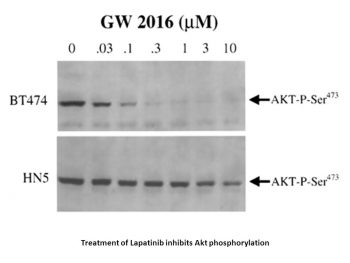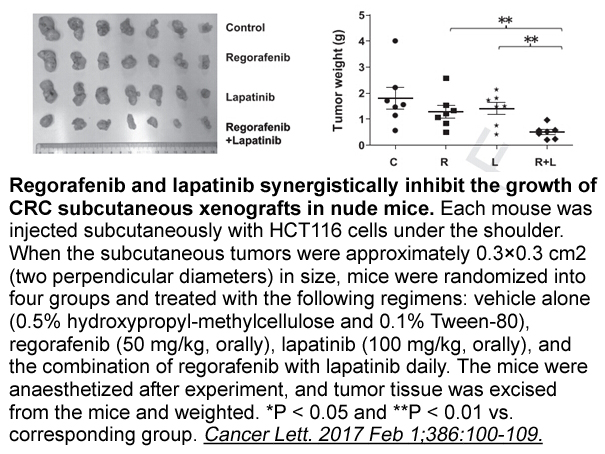| CAS NO: | 231277-92-2 |
| 规格: | ≥98% |
| 包装 | 价格(元) |
| 100mg | 电议 |
| 250mg | 电议 |
| 500mg | 电议 |
| 1g | 电议 |
| 2g | 电议 |
| 5g | 电议 |
| 10g | 电议 |
| Molecular Weight (MW) | 581.06 |
|---|---|
| Formula | C29H26ClFN4O4S |
| CAS No. | 231277-92-2 (free base); |
| Storage | -20℃ for 3 years in powder form |
| -80℃ for 2 years in solvent | |
| Solubility (In vitro) | DMSO: 100 mg/mL (108.1 mM) |
| Water: <1 mg/mL | |
| Ethanol: <1 mg/mL | |
| Solubility (In vivo) | 2% DMSO+30% PEG 300+5% Tween 80+ddH2O: 10 mg/mL |
| Synonyms | Lapatinib; Lapatinib ditosylate; GW2016; gw572016; gw 572016;GW-2016; GW 2016; GW-572016; GSK572016; GSK 572016; gw-572016; Trade name: Tykerb Chemical Name: N-(3-chloro-4-((3-fluorobenzyl)oxy)phenyl)-6-(5-(((2-(methylsulfonyl)ethyl)amino)methyl)furan-2-yl)quinazolin-4-amine SMILES Code: O=S(CCNCC1=CC=C(C2=CC3=C(NC4=CC=C(OCC5=CC=CC(F)=C5)C(Cl)=C4)N=CN=C3C=C2)O1)(C)=O |
| In Vitro | In vitro activity: Lapatinib weakly inhibits the activity of ErbB4 with IC50 of 367 nM, and displays>300-fold selectivity for EGFR and ErbB2 over other kinases such as c-Src, c-Raf, MEK, ERK, c-Fms, CDK1, CDK2, p38, Tie-2, and VEGFR2. Lapatinib significantly inhibits receptor autophosphorylation of EGFR and ErbB2 in a dose-dependent manner with IC50 of 170 nM and 80 nM, respectively in HN5 cells; as well as 210 nM and 60 nM, respectively in BT474 cells. Unlike OSI-774 and Iressa (ZD1839) which preferentially inhibit the growth of the EGFR-overexpressing cells, Lapatinib inhibits the growth of both EGFR- and ErbB2-overexpressing cells. Lapatinib displays higher inhibitory activity against EGFR- or ErbB2-overexpressing cells with IC50 of 0.09-0.21 μM, compared with cells expressing low levels of EGFR or ErbB2 with IC50 of 3-12 μM, and exhibits ~100-fold selectivity over the normal fibroblast cells. Lapatinib potently inhibits the outgrowth of EGFR-overexpressing HN5 and A-431 cells, as well as ErbB2-overexpressing BT474 and N87 cells, and significantly induces G1 arrest of HN5 cells and apoptosis of BT474 cells, which are associated with inhibition of AKT phosphorylation. Kinase Assay: The IC50 values for inhibition of enzyme activity are generated by measuring inhibition of phosphorylation of a peptide substrate. The intracellular kinase domains of EGFR and ErbB2 are purified from a baculovirus expression system. EGFR and ErbB2 reactions are performed in 96-well polystyrene round-bottomed plates in a final volume of 45 μL. Reaction mixtures contain 50 mM 4-morpholinepropanesulfonic acid (pH 7.5), 2 mM MnCl2, 10 μM ATP, 1 μCi of [γ33P] ATP/reaction, 50 μM Peptide A [Biotin-(amino hexonoic acid)-EEEEYFELVAKKK-CONH2], 1 mM dithiothreitol, and 1 μL of DMSO containing serial dilutions of Lapatinib beginning at 10 μM. The reaction is initiated by adding the indicated purified type-1 receptor intracellular domain. The amount of enzyme added is 1 pmol/reaction (20 nM). Reactions are terminated after 10 minutes at 23°C by adding 45 μL of 0.5% phosphoric acid in water. The terminated reaction mix (75 μL) is transferred to phosphocellulose filter plates. The plates are filtered and washed three times with 200 μL of 0.5% phosphoric acid. Scintillation cocktail (50 μL) is added to each well, and the assay is quantified by counting in a Packard Topcount. IC50 values are generated from 10-point dose-response curves. Cell Assay: Cells are exposed to various concentrations of Lapatinib for 72 hours. Relative cell number is estimated using methylene blue staining. The absorbance at 620 nm is read in a Spectra microplate reader. Cell death and cell cycle analysis are assessed by propidium iodide staining and antibody detection of incorporated BrdUrd and staining with propidium iodide. |
|---|---|
| In Vivo | Oral administration of Lapatinib (~100 mg/kg) twice daily significantly inhibits the growth of BT474 and HN5 xenografts in a dose-dependent manner. |
| Animal model | CD-1 nude female mice implanted s.c. with HN5 cells, and C.B-17 SCID female mice implanted s.c. with BT474 cells. |
| Formulation & Dosage | Dissolved in a vehicle of sulfo-butyl-ether-β-cyclodextrin 10% aqueous solution (CD10); 100 mg/kg; Oral gavage. |
| References | Mol Cancer Ther. 2001 Dec;1(2):85-94; Cancer Res. 2006 Feb 1;66(3):1630-9. |
|  |  |
